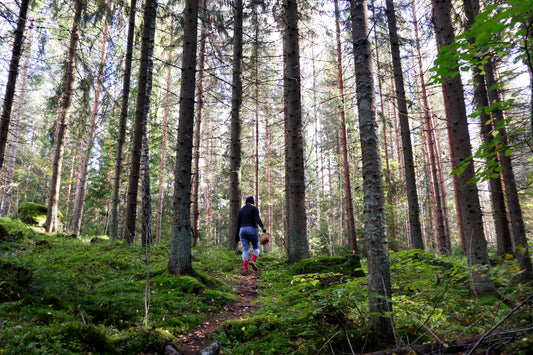As the days get shorter and the clocks go back, maintaining an active outdoor routine may feel more challenging. Yet, with the right mindset and a few helpful tips, you can still make the most of the outdoors, whether you’re going solo or bringing friends along. Here’s your comprehensive guide on how to stay motivated, plan your time well, and prioritise safety as you embrace the season’s unique beauty.

1. Set Clear Intentions and Goals for the Season
Staying motivated is all about having a clear “why.” As autumn sets in, take a few moments to reflect on what you love about being outdoors. Do you want to stay physically active, connect with nature, relieve stress, or simply enjoy fresh air? Having a purpose behind your outings can make a huge difference. Consider setting personal goals:
- Weekly Activity Goals: Aim to spend at least 3-4 days outside, whether it’s a 20-minute walk or a full-hour hike.
- Tracking Progress: Use an app or journal to keep a record of your activities. Seeing how much you’ve done can be a strong motivator to continue.
Seasonal Reflection Exercise:
Before the first real chill hits, jot down three things you love about autumn and winter. These reminders can help keep you positive and driven as you venture out each week.

2. Plan ahead for the Best Times of the Day
With less daylight, timing is everything. You can optimise your outdoor time with a bit of forethought:
- Identify Peak Sunlight Hours: For many, late mornings or early afternoons have the most natural light and warmth, so plan for outdoor activities during these hours.
- Utilise Your Calendar: Schedule your outdoor time like any other appointment, blocking out chunks of time when you’re least likely to be distracted or interrupted.
3. Make It a Social Affair
If solo outings feel tough, involving friends or family can give you an extra boost of motivation. Being active with others creates accountability and makes your time outdoors more enjoyable.
- Set Up a Weekly “Adventure Club”: Pick a time each week to meet up with friends for a hike, walk, or bike ride. By turning it into a regular event, you’ll keep each other motivated and look forward to your time together.
- Friendly Challenges: Create a challenge—like hitting a certain number of steps per week or exploring a new park each month—to keep things fresh and interesting.

4. Adjust Your Routine with the Season
Adapting to the colder months means making small adjustments that keep your routine both enjoyable and safe.
- Layer Up with Comfort and Warmth: We are all about the layers! But it is advisable to Invest in layers of performance clothing that are breathable, moisture-wicking, and insulating. It is so much easier to get motivated when you love what you are wearing and feel comfortable and warm.
- Find New Local Spots to Explore: The changing scenery is a great excuse to explore local nature spots or trails you haven’t tried before. Discovering a new place can spark a sense of adventure that’ll keep you coming back.
Tip: Remember “The 10-Minute Rule”
If you’re feeling unmotivated, try the “10-Minute Rule.” Commit to being outside for just ten minutes; you’ll often find that once you’re out, it’s easier to keep going.
5. Focus on Mindful Movement
Shorter days mean that each moment outdoors is an opportunity to slow down and be present. Practising mindful movement, like nature walks or gentle yoga, can deepen your connection to the outdoors and leave you feeling rejuvenated.
- Engage Your Senses: Notice the earthy smells, listen to the crunch of leaves, or feel the crisp air on your skin. This sensory engagement can lift your mood and make your outdoor experience more fulfilling.
- Appreciate Small Wins: Reflect on the positive impact that being outside, even briefly, has on your mood, energy, and focus.

6. Prepare for Safety During Darker Hours
With earlier sunsets and later sunrises, it’s important to take a few simple precautions to ensure your outdoor time is safe.
- Wear Reflective Gear: Bright or reflective clothing and accessories (like armbands or shoe clips) make you visible to others when the light is low.
- Bring a Light Source: A small flashlight or headlamp can light up paths, help you avoid obstacles, and alert others to your presence.
- Stick to Familiar Paths: In low light, it’s best to stick to well-known routes. This minimises the risk of getting lost and helps you stay mindful of any potential hazards.
- Use Location-Sharing Apps: If you’re venturing out alone, share your location with a friend or family member. This added precaution provides peace of mind and ensures someone knows your whereabouts.
Tip: Buddy System for Safety
If you’re venturing into low-light conditions, consider inviting a friend along or keeping your dog with you. Having someone (or a four-legged companion) around can add an extra layer of safety and make the experience more enjoyable.
7. Embrace the Power of Nature Therapy
The benefits of being in nature are well-documented and extend beyond physical fitness. Spending time outdoors in green spaces reduces stress, improves mood, and increases your sense of well-being—especially valuable during the darker months when daylight exposure can be limited.
- Forest Bathing: Spend time in wooded areas, and try to immerse yourself in the sights, sounds, and smells of nature. This type of natural “therapy” can boost mood and promote relaxation.
- Practise Gratitude Outdoors: Whether alone or with friends, take a moment to appreciate something about each outing. You may find that even a small dose of gratitude has a powerful effect on your mood.

8. Keep It Fun and Flexible
Motivation wanes when routines become monotonous. Keep your outdoor adventures fresh by mixing up your activities.
- Try a Variety of Activities: Go for a brisk walk one day, a nature photography outing the next, or even a jog if you’re feeling energised. Variety prevents boredom and keeps your outings interesting.
- Add Playful Elements: If you’re with friends, add a game element—like a photo challenge to capture autumn leaves, or finding the best view spot—to make the time more enjoyable.

9. Balance Rest and Activity
It’s natural to feel a bit more fatigued as the days get shorter, so it’s important to listen to your body and find a balance between staying active and resting.
- Set a Consistent Sleep Schedule: Aim for good sleep hygiene by going to bed and waking up at the same time daily. This will help you feel more energised and motivated for daytime activities.
- Listen to Your Body: Some days, a gentle walk may feel right, while on others, you might feel up for a longer hike or jog. Honour these natural fluctuations and adapt your routine accordingly.
10. Reflect on Your Progress and Celebrate Small Wins
Finally, celebrate your dedication to staying active, especially on the days it feels harder to get out. Reflect on each week’s achievements, no matter how small. This sense of accomplishment will keep you motivated and remind you of the benefits that come with staying connected to the outdoors.
- End-of-Week Reflection: Dedicate time each week to think about what you’ve achieved, any new spots you’ve explored, or any goals you’ve met. These reflections can help reinforce the habit and remind you of your progress.

Conclusion: Embrace the Beauty of the Season
As the daylight hours dwindle, remember that getting outdoors can be a simple yet powerful way to stay grounded, energised, and connected to nature. By setting intentions, planning strategically, and embracing the beauty of each moment outside, you can turn autumn and winter into a season of growth and adventure. So layer up, step outside, and find joy in the crisp air and changing landscapes.
Happy exploring, and here’s to many rewarding, safe, and joyful adventures in the months ahead!
Sunday Inspiration
Favourite Podcast

Autumn Soup Recipe
Sweet Potato Soup from loveandlemons.com

- Sweet potatoes, of course! They give the soup its sweet flavour, vibrant colour, and luscious texture.
- An apple – It brings out the sweetness of the sweet potatoes.
- Onion and garlic – For savoury depth of flavour.
- Coriander and ginger – They add warm, aromatic flavour to the soup.
- Smoked paprika – It gives the soup its delicious smokiness.
- Extra-virgin olive oil and coconut milk – For richness.
- Vegetable broth – Use store-bought, or make your own.
- Apple cider vinegar – For tang.
- And sea salt – To make all the flavours pop!
Favourite Song
This is the Kit - Moonshine Freeze




